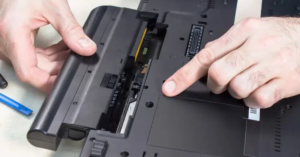Laptop computers have come a long way from their bulky beginnings to the slim, powerful devices we use today. This blog explores the key milestones in laptop development, highlighting major innovations that shaped modern portable computing. Dive into the fascinating journey of laptop technology and how it transformed the way we work and live.
Let’s explore about components of a laptop.
History of Laptop Computers
1975 – IBM 5100: First Portable Computer

In September of 1975, IBM debuted the IBM 5100, the first really portable computer. It tipped the scales at 55 pounds and wasn’t precisely light by today’s measures, but it was much smaller and more transportable than the vast, room-filled computers of the day.
1976 – Alan Kay’s Dynabook
The idea of the modern laptop can be traced back to Alan Kay in 1976. While working at Xerox PARC (Palo Alto Research Center), Kay envisioned a Dynabook, a portable computer designed for personal use and education. Although the Dynabook was never fully built, it became the inspiration for portable computing devices, influencing the development of later laptops. Xerox eventually developed a prototype, the Xerox Note Taker, based on Kay’s ideas.
1979 – GRiD Compass: The First Clamshell Laptop

In 1979, Bill Moggridge designed the GRiD Compass, the first true clamshell laptop, with a screen that folded over a keyboard. The GRiD Compass, weighing 10 pounds, was the most portable computer of its time and was notably used by NASA during the early 1980s in its Space Shuttle program. The GRiD Compass set the stage for the familiar form factor we associate with laptops today.
1981 – Osborne 1: The First Portable Computer

The Osborne 1, released in April 1981, is often considered the first truly portable computer. Developed by Adam Osborne, it weighed 24.5 pounds and featured a 5-inch screen. The Osborne 1 ran the CP/M operating system and was aimed at business users. Despite its bulky design, it revolutionized the concept of portable computing, making personal computers more accessible and mobile.
In 1982, Epson released the HX-20, the first portable computer with a built-in printer, adding extra functionality for mobile professionals.
1983 – TRS-80 Model 100: One of the First LCD Displays

In 1983, Radio Shack released the TRS-80 Model 100, a portable computer featuring one of the first LCD screens. Initially manufactured by Kyocera and sold in Japan, it was later brought to the United States under the Radio Shack brand. The TRS-80 Model 100 was particularly popular among journalists and writers due to its compact design and full-size keyboard.
1984 – Commodore SX-64: First Portable Computer with Color Display

Commodore introduced the SX-64 in 1983 December, early 1984, the first portable computer to feature a full-color display. Weighing around 20 pounds, the SX-64 also came with a built-in disk drive and was capable of running Commodore 64 software. It was a significant step forward in portable computing, but still, it was far from the ultra-portable laptops we have today.
1986 – IBM PC Convertible: The First Laptop Under 15 Pounds
In 1986, IBM launched its PC Convertible, the first laptop to weigh less than 15 pounds (12 pounds, to be exact). This was a major milestone, as it made portable computers more practical for business use and began to push the envelope on mobility and functionality.
1989 – Apple Macintosh Portable: Apple’s First Laptop

Apple entered the laptop market in 1989 with the Macintosh Portable. Despite its high price tag of $6,500, it was a commercial failure due to its weight (16 pounds) and limited battery life. However, it paved the way for future Apple laptops, especially the PowerBook line that followed.
1991 – Apple PowerBook: Redefining the Laptop Design
In 1991, Apple redefined the portable computer with the release of the PowerBook series. The new PowerBooks were lighter and more ergonomic, featuring a trackpad (a new method of cursor control) and a more comfortable keyboard layout. This helped Apple set a new standard for laptop design and usability.
1992 – IBM ThinkPad: The Start of an Iconic Line

IBM introduced its ThinkPad 300, 700, and 700C models in 1992. The ThinkPad became known for its durability, portability, and robust design, quickly becoming a staple in the business world. These laptops were also known for the TrackPoint, a small red button in the middle of the keyboard used for navigation.
1993 – Compaq Concerto: The First 2-in-1 Laptop
Compaq introduced the Concerto in 1993, a revolutionary 2-in-1 laptop featuring a detachable keyboard and a stylus for touch input. The Concerto was the precursor to the hybrid laptops and convertible designs we see today.
1994 – IBM ThinkPad 775CD: First Laptop with a CD-ROM Drive
In 1994, IBM released the ThinkPad 775CD, the first laptop to feature an integrated CD-ROM drive. This was a major milestone, as it allowed users to access software and media directly from the laptop without needing an external device.
1997 – Toshiba Portege 300CT: First Ultraportable Laptop

In 1997, Toshiba released the Portege 300CT, the first laptop to weigh under 3 pounds, marking the start of the ultraportable laptop era. The Portege 300CT became a key model for those looking for compact computing on the go.
2003 – Apple PowerBook G4: First Laptop with a 17-inch Screen
Apple’s PowerBook G4 (2003) introduced the first 17-inch laptop. It also featured 802.11g Wi-Fi and a backlit keyboard, offering unprecedented connectivity and ease of use. This model pushed Apple’s dominance in the professional and creative markets.
2007 – ASUS Eee PC 701: The First Netbook
In 2007, ASUS released the Eee PC 701, a compact laptop with a 7-inch screen that introduced the netbook category to the world. The netbook was an affordable, lightweight option for basic computing tasks, sparking a huge demand for small, low-cost laptops.
2008 – Apple MacBook Air: The Thinnest Laptop Ever

Apple’s MacBook Air, released in 2008, made waves by being the thinnest laptop ever at the time, measuring just 0.16 inches at its thinnest point. It set a new standard for ultraportable laptops and cemented Apple’s reputation for design excellence.
2011 – The Rise of Chromebooks
In 2011, Acer and Samsung released their first Chromebooks at the Google I/O conference. Chromebooks run Google Chrome OS, which is based on cloud computing, offering users a lightweight, efficient computing option with excellent online integration.
2023 – OLED Displays in Laptops
In 2023, Samsung began manufacturing OLED screens for laptops, offering 13-inch and 16-inch displays with 3K resolution and 120 Hz refresh rates. OLED technology provides stunning color accuracy and deep blacks, further enhancing the visual experience of laptops.
Conclusion
Significant advances in technology during the laptop’s history from the 1970s to the present have made these devices strong and flexible instruments. The path of laptops, from the heavy and constrained early models like the IBM 5100 to the modern, sleek, high-performance devices, is symbolic of broader developments in computing, such as reduced size, increasing processing power, longer battery life, and improved connection.
Today’s different types of laptops offer a degree of performance, portability, and functionality that was previously unthinkable, whether for business use, gaming, or daily duties. As we look ahead to the future of laptops, it’s exciting to imagine how laptops work and will evolve to become even more efficient and versatile devices, building on the rich history of laptop computers.
FAQ’s
What is the history behind the first laptop?
The concept of a portable computer began in the 1970s with Xerox’s Dynabook, envisioned as a tablet-like device for educational and personal use. However, it was not until the early 1980s that the first commercially available laptops emerged. The Osborne 1 (1981) is often considered the first true laptop, with a design that included a built-in screen and keyboard, but it was still relatively bulky.What was the IBM 5100?
The IBM 5100, introduced in 1975, was one of the first portable computers, though it was not a laptop in the modern sense. It was relatively heavy, weighing around 55 pounds (25 kg), and featured a built-in screen and keyboard.How did early laptops differ from today’s laptops?
Early laptops, such as the Osborne 1 and Compaq Portable, were large, heavy, and often cumbersome compared to today’s laptops. They had limited processing power, small screens, and short battery life. Modern laptops are much slimmer and lighter, with high-resolution displays, powerful processors, extended battery life, and advanced features like touchscreens, solid-state drives (SSD), and high-speed connectivity options.How has laptop technology improved over the years?
Laptop technology has come a long way over the years. Nowadays, laptops are faster and more efficient, with better battery life and sleeker designs. They’re also lighter and have sharper, more vibrant screens. Plus, improved connectivity options and sturdier builds mean they’re more reliable and user-friendly than ever.Which generation laptop should I buy in 2024?
In 2024, the choice of laptop generation depends on your specific needs. Best 13th generation laptops in 2024 are Dell Inspiron 3530, Lenovo IdeaPad Flex 5, Samsung Galaxy Book3, Acer Predator Helios Neo 16, Asus Vivobook 15X.What are some major milestones in laptop history?
1975: Introduction of the IBM 5100, an early portable computer.1981: Launch of the Osborne 1, considered the first true laptop.
1989: Release of the Compaq LTE, one of the first truly portable laptops.
1991: Introduction of the Apple PowerBook, which featured an innovative design with the keyboard pushed back to create a more ergonomic user experience.
2008: Launch of the MacBook Air, known for its thin profile and lightweight design, setting a new standard for ultra-books.
2020: Apple’s introduction of the M1 chip, marking a significant leap in performance and efficiency for laptops.











1 thought on “History of Laptop Computers | A Comprehensive Overview”
Thank you for sharing your thoughts. I really applreciate your efforts aand I am waiting
for your further post thanks once again. https://menbehealth.wordpress.com/